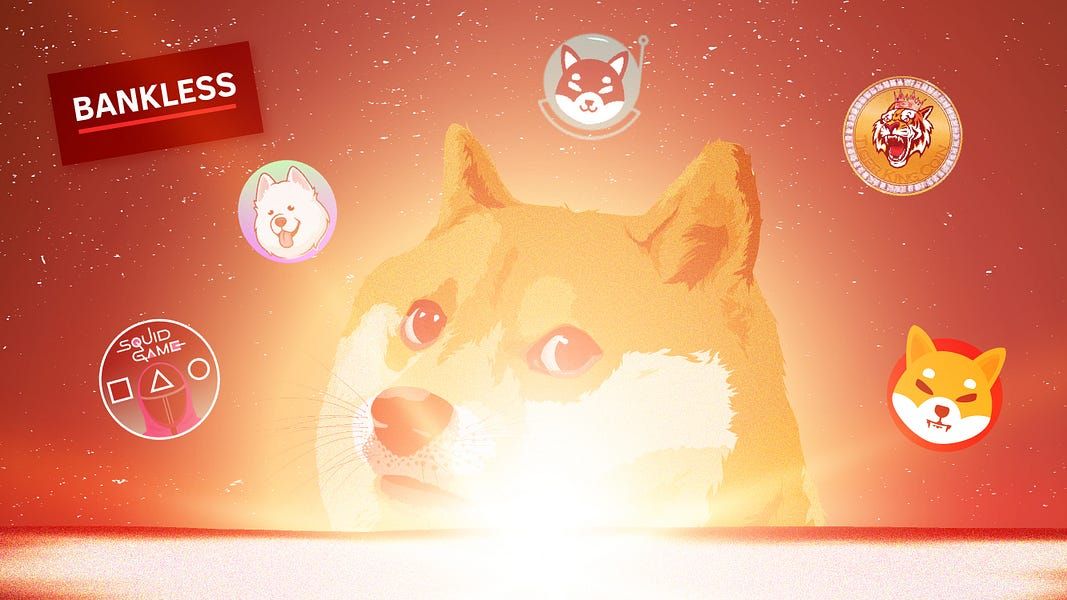The Meme Economy

Dear Bankless Nation,
When SHIB pumped last week did any of you get texts from your extended family and friends asking if they should buy it?
Annoying? I get it. We talk about long-term investing and fundamentals so often on Bankless and then here’s this dog token mooning based on pure memecraft.
So which is it… do meme-coins damage the ecosystem or are they net positive?
More importantly—is there anything we can learn from them?
Remember the Gamestop frenzy last January. What CNBC dismisses as a bunch of Reddit degens shilling their latest group bet ended up being a sharp criticism of a centralized and privileged financial system. It captured the news cycle for weeks at a time and alerted a new wave of people to hedge funds, shorting, ghost shares, and other problematic elements of a flawed system.

Memes are a viral lingua franca that resonates with a global audience. They bring people into the fold and open their minds to new ways of thinking.
They arise from the bottom up and spread using the internet as a propagation layer.
Let’s explore.
Mason has more in this week’s piece on The Meme Economy.
- RSA
P.S. Happy Diwali to all of our Indian readers!
Guest Writer: Mason Marcobello, freelance writer & entrepreneur
As we’ve seen through the riotous ascent of projects like "CrypToadz" by the Evil King Gremplin, communities are, by and large, a primal catalyst behind the success or collapse of various protocols, dApps, or in the example of Gremplin, what many now playfully deem as “illiquid Jpegs” (NFTs).
But with this in mind, there is another factor, a proverbial glue of sorts, that helps solidify and strengthen these very communities whilst also propagating their thoughts or ideas to the wider world. Memes.
Unbeknownst to many, the origins of memes and their formal subject matter (known as memetics) date as far back as the 1970s. Particularly notable was the mention of memes in Richard Dawkins's 1976 book "The Selfish Gene", where it functioned with a meaning other than the current association to social media. Quite simply, Dawkins conception of the term meme is "as a unit of cultural information" - the cultural equivalent of a gene. Dawkins further elaborated on what the word was intended for:
“…Examples of memes are tunes, ideas, catch-phrases, clothes fashions, ways of making pots or of building arches. Just as genes propagate themselves in the gene pool by leaping from body to body via sperms or eggs, so memes propagate themselves in the meme pool by leaping from brain to brain via a process which, in the broad sense, can be called imitation.”
Overall, conventional thought understands Dawkins' sense of meme as "an idea, behaviour, style, or usage that spreads from person to person within a culture." Fast-forwarding several decades, memes are now more or less referred to as amusing, widespread, and contagious pieces of online content like a captioned picture or video.
However, when it comes to crypto-economics, memes fulfill a dualistic and (at times) polarising role. On the one hand, some purists criticise meme-centric coins, arguing that they nullify the underlying power and purpose of decentralised tech. On the other hand, there is undeniable value in the playful humour that rests on the surface of what most consider intimidating and obfuscated subject matter.
We can see a similar notion and strategy mirrored through the approach of revered comedians like Dave Chappelle. As layered underneath entertaining stories about Rick James or Mickey Mouse at Disney World are harsh or, at times, disturbing truths about our social and historical discourse as human beings. In a similar light, we can argue that so too do crypto memes initially captivate audiences with their light-hearted silliness while also retaining deeper subtext and meaning through the technology and culture that surrounds them. And by doing so, functions as a well-disguised “foot in the door” strategy to a class of people who would be otherwise exhausted, mentally drained, or disenfranchised to learn more about the necessity of these emerging technologies.
To better understand the inherent power of memes in their ability to captivate audiences and strengthen adoption rates, we can consider the history and evolution of DOGE coin.
History of DOGE
As many already know, DOGE started as a light-hearted joke between co-creators Billy Markus and Jackson Palmer. During a time when the overarching seriousness of Bitcoin permeated the global crypto-discourse, the creation of a "fun and friendly internet currency" made to be ridiculous as possible came as a breath of fresh air. People who wanted to easily mint and play around with something that cost fractions of a cent could do so with little risk. As a result (or perhaps a direct influence of these factors), the DOGE website reportedly received over one million visits approximately one month after its launch. Within two weeks of the project going live on December 6, 2013, the r/Dogecoin Reddit channel had over 19,000 users, and DOGE's price skyrocketed 300%, despite China announcing a ban on payment companies from dealing with Bitcoin at the time.
Community Value and Support
Another contributing factor to the success and receptivity of DOGE coin was the pre-existing love of the coin’s mascot - a popular meme of a Japanese Shiba Inu “doge” known for nonsensical phrases like “much wow” and “such tired.” The meme was originally created in 2010 after Japanese kindergarten teacher Atsuko Sato posted several photos of her rescue-adopted Shiba Inu dog Kabosu to her personal blog. Among the photos included a peculiar shot of Kabosu sitting on a couch while glaring sideways at the camera with raised eyebrows. After media outlets like The Verge published articles identifying Sato's Kabosu as the original Shiba Inu depicted in the meme, the image and content only gained further popularity online.

Given this contextual awareness, we can observe that by aligning the coin to a topic that already had growing supporters (doge), Jackson and Billy were able to leverage the psychological element of social proof with people already emotionally invested to the meme itself. In addition, despite the nonsensical nature of DOGE, like it being a fork of Lucky Coin and having a total supply of 100 billion coins - the community rallied behind the currency in 2014 after hacks and critiques to prove it did have practical utility.
Some examples included raising $30,000 in a few hours to help the Jamaican bobsled team attend the 2014 Winter Olympics in Sochi, Russia. Another DOGE community-driven initiative called “Doge4Kids” involved a successful donation of $30,000 for the 4 Paws For Ability charity - an organisation that helps provide service dogs to special needs children.

All this considered, there are further elements that meme coins like DOGE help contribute when it comes to the adoption and awareness of web3. Most prevalent of these are the invaluable assets of time and attention. This has been especially highlighted through its affinity from celebrities like Snoop Dog, Lil Yachty, and Mia Khalifa - not to mention, and most infamous of all, Elon Musk.
Time & Attention - Stregthening Adoption
To demonstrate how Elon’s embrace of DOGE helps bring further adoption and awareness into the crypto ecosystem we can consider the analogy of YouTube.
Over the span of 16 years (since its inception on Feb 14th, 2005), YouTube as a platform that has gained approximately 2.3 billion users worldwide. The users of which watch over one billion hours of videos every single day and are responsible for generating 720,000 hours of daily content in over 100 countries. To put this in perspective, one billion hours is the rough equivalent to 115,000 years. 720,000 hours is the equivalent of 82.13552 years. That’s what Youtube generates in content per day.
The streamlined diversity of content on YouTube is one of the many reasons why it has exploded in popularity over the years. And more importantly, it’s all interconnected on a singular platform, regulated by algorithms that are designed to retain the only thing that matters - audience time, energy, and attention.
According to Google statistics, the two top reasons that viewers watch YouTube are "to relax" and "to feel entertained.” But from the perspective of YouTube, it doesn’t necessarily matter. The only thing that matters (in the broad scheme) is that they’re kept watching. Suppose we liken YouTube to the overarching network of web3 platforms and cryptocurrencies as a whole. In such a light, a similar argument could be made that although figures like Elon are propagating meme coins that would be the equivalent of a "Daily Dose of Internet" clip, an even more significant asset is being traded as a result. The time, attention, and awareness of the public. Regardless of the methodology, the media discourse surrounding events like Elon’s appearance and DOGE discourse on Saturday Night Live has invariably helped move decentralised digital assets into the zeitgeist, whereas in the past, it would be on the periphery of a specialised niche or subset.
Building from the Ground Up
As mentioned, the attractiveness of meme coins through their inherent affordability gives communities a chance to align with a prevalent theme of crypto-building from the bottom up. Although this notion is already reflected through Bitcoin's pre-existing system of divisibility known as "satoshis", displaying exact dollar equivalent values for both smaller and larger denominations in "sats" still causes a large amount of confusion for most people. However, meme coins like Doge or Shiba Inu have the potential to supersede this by providing opportunities for a broader demographic of people to own and use "whole coin" equivalents without risking their life savings or over-leveraging positions based on pure speculation. The downside, however, is that this very element of wider, public accessibility also opens up the potential for inexperienced traders and investors to later fall victim to nefarious rug pulls or price manipulation. In essence, although it may appear more attractive or exciting to own 100 million meme coins, the reality is that there are no shortcuts to true wealth creation - regardless of how appealing narratives and marketing endeavours may seem.
“The People’s Crypto” - Mocking Legacy Systems
A further underlying factor contributing to the power of memes that not many may consider when analysing the intentions of public figures like Musk is their inherent ability to mock legacy systems. If anything, Richard Nixon’s actions in 1971 to end dollar convertibility to gold and implement wage/price controls only further highlighted the innate malleability of money as a tool shaped according to the incentives and benefit of centralised monoliths.
Through this angle, it can be argued that meme coins like Doge are the complete antithesis - developed and supported by digital natives to exchange and share value online. There are no nefarious incentives or manipulative intentions for the average meme (regardless of an associated coin or not). And in that sense, while the Fed may conjure up trillions of inherently empty dollars, (although still just a hypothesis) so too is Elon using the example of Doge in a way to demonstrate that the current system can be replaced with something equally laughable.
Flow on Effects
Reflecting on the above examples and focal points, it's not hard to understand that memes and associated coins are perhaps as much representative of web3 culture as Satoshi himself. More importantly, as exampled by serial entrepreneur, angel investor, and essayist Balaji Srinivasan there is a gradual economy that memes are creating to complement, or perhaps evolve as an emerging sub-genre within the NFT sector.
Referencing Balaji’s words: “The meme economy will become real. Meme creators will make NFTs. Timestamps give proof-of-first. Memers become millionaires. Risky art becomes uncensorable, monetizable, and moves outside regime control.” But perhaps all this is to be explored at a later time.